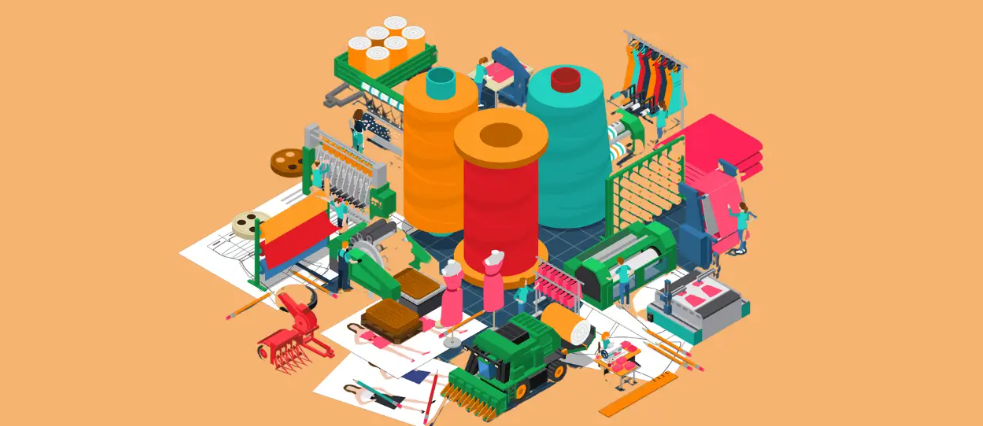2024/2/22

I. Industry prosperity and production performance
In 2023, China’s textile industry experienced severe challenges in production and marketing due to the complex external environment. The pressure on enterprise production and operation has increased. Supported by a series of national policies to stabilize growth, the development expectations and confidence of textile enterprises gradually improve. According to the survey data from the China National Textile and Apparel Council, the comprehensive prosperity index of the textile industry in the four quarters of 2023 was 55.6%, 57%, 55.9%, and 57.2% respectively, indicating a rebound to higher levels in recent years.
The textile industry’s capacity utilization rate and production are steadily increasing. According to the National Bureau of Statistics, in 2023, the textile industry and chemical fiber industry had a capacity utilization rate of 76.4% and 84.3% respectively, both higher than the national industrial capacity utilization level for the same period. In particular, the capacity utilization rate of the chemical fiber industry increased by 2 percentage points compared to the previous year. In 2023, the industrial added value of large-scale enterprises in the textile industry decreased by 1.2% compared to the previous year, which is an improvement of 0.7 percentage points from 2022.
II. Domestic demand and exports
In 2023, the diverse and personalized clothing consumption demand of residents increased rapidly; the recognition of independent brands and the “guochao” or “Chinese fashion trend” has improved. Domestic demand for textile and apparel in China continues to show improved momentum. National Bureau of Statistics data show that in 2023, the retail sales of clothing, foot & head wear and knitted goods above the designated size grew by 12.9% year-on-year, seeing a sharp increase of 19.4 percentage points than that of 2022; the overall retail scale exceeded the level before the pandemic. Driven by positive factors such as the improved online shopping experience and the thriving e-commerce industry, the retail growth rate of online channels bounced back. In online retail sales of physical goods, the sales of sporting goods increased by 10.8% year-on-year, which is 7.3 percentage points higher than in 2022.
Affected by reduced demand from overseas, increased trade risks, and other factors, China’s textile industry experienced a significant increase in export pressure in 2023. However, the industry’s resilience in foreign trade development continues to show. Exports to the “Belt and Road” market are growing at a better rate, gradually reducing the decline. In 2023, China’s total textile and apparel exports reached US$ 293.64 billion, representing an 8.1% year-on-year decrease according to the China Customs Express data. Among the major export products, the export value of textiles (textile yarns, fabrics, and manufactured products) was US$ 134.5 billion, showing an 8.3% decrease compared to the previous year, while the export value of apparel was US$ 159.14 billion, marking a 7.8% decline year-on-year. In terms of main export markets, China’s textile and apparel exports to the United States, the European Union, Japan, and other markets have decreased compared with the previous year. At the same time, exports to countries along the “Belt and Road” Initiative, such as Türkiye, Russia, and others, have been steadily increasing.
III. Benefit and investment
In 2023, textile enterprises operated under pressure due to sluggish market demand, high costs, and other factors; however, benefits steadily improved supported by rebounded domestic demand. According to the National Bureau of Statistics data, business revenue of textile enterprises above designated size decreased by 0.8% year-on-year in 2023, 0.1 percentage points narrower than the previous year; total profit increased by 7.2% year-on-year, surged by 32 percentage points compared with 2022. Operating income margin recovered to the year’s highest level of 3.8%, which was 0.3 percentage points higher than in 2022. The vast sectors in the industry chain saw improved benefits over the previous year. Among them, the chemical fiber, woolen textiles, silk, filament weaving, printing, and dyeing industries achieved year-on-year growth.
Under weak market demand, textile businesses still lack confidence in making investments. Continuous improvement in profitability and an accelerated pace of transformation and upgrading have led to a reduction in investment decline. Last year, fixed-asset investment in China’s textile, apparel, and chemical fiber industries decreased by 0.4%, 2.2%, and 9.8% year-on-year. This decline narrowed by 10.6, 3.5, and 1.8 percentage points respectively compared to the lower level of 2023.
IV. Promoting stability through progress, and laying the foundation for the development of new textile industrialization
Looking ahead to 2024, China's textile industry still faces many uncertain factors in its development. Maintaining a stable and improving recovery trend will still face many challenges. Coupled with the tightening of monetary policy in major developed economies, the international political and economic environment is complex. The “de-risking” policy of some developed countries increases the risk of global decoupling and supply chain disruption. The global industrial and supply chains of the textile industry continue to adjust.
Fortunately, China’s domestic market is being driven by a new type of urbanization and urban-rural integration, which is boosting the high-quality development of the textile industry. Great health, green ecology, and intelligent life energize modernization, as does “guochao,” which refers to the Chinese fashion trend. The “Belt and Road” Initiative and high-standard free trade zone network also create a foundation for the textile industry to expand into diversified international markets and establish an international supply chain system. This plays a crucial role in managing and mitigating the impact of external risks.
Source: CHINA TEXTILE LEADER Express



Authority in Charge: China National Textile and Apparel Council (CNTAC)
Sponsor: China Textile Information Center (CTIC)
ISSN 1003-3025 CN11-1714/TS
© 2025 China Textile Leader, all rights reserved.
Powered by SeekRay